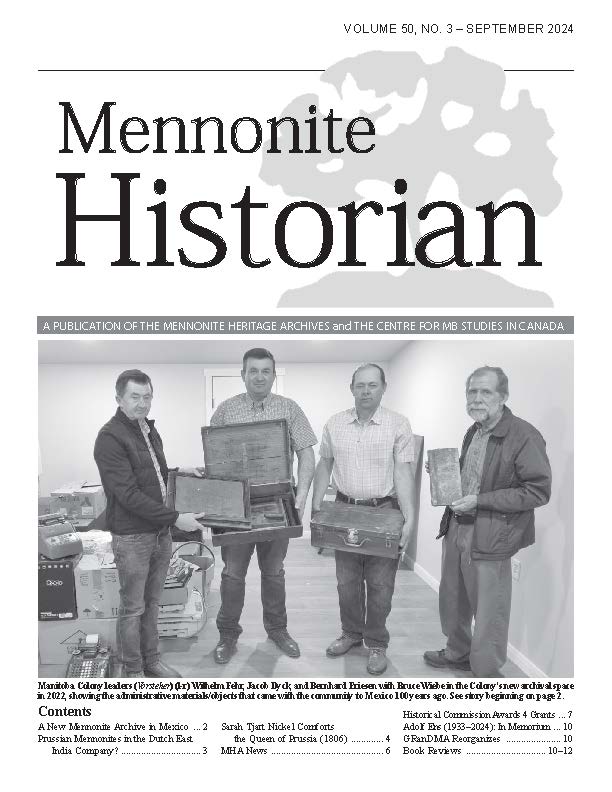
The Mennonite Historian began in 1975 and is published by the Mennonite Heritage Archives.
Editors: Hans Werner and Conrad Stoesz (MHA)
All correspondence and unpublished manuscripts should be sent to the editorial offices at:
Mennonite Heritage Archives (MHA)
500 Shaftesbury Blvd.
Winnipeg, MB R3P 2N2
Canada
(204)560-1998
Subscription rates:
- 1 year – $17.00 CAN or $17.00 US
- 2 years – $32.00 CAN or $32.00 US
- 3 years – $46.00 CAN or $46.00 US
Individual subscriptions may be ordered from the contacts above or on the CommonWord website.
Back issues can be obtained at the Mennonite Historian website.
Periodical number: ISSN 0700 8066
Highlighted Articles
- Vol. 48 No. 2 June 2022 “Elder Ordinations in the Conference of Mennonite in Canada”
- Vol. 48 No. 1 March 2022 “Falk Sisters Album”
Falk Sisters Album
The Falk Sisters
“Sing Unto the Lord”
1963
“Sing unto the Lord, for he hath done excellent things; this is known in all the earth.” Isaiah 12:5
The Falk Sisters sang together as a quartet until 1958 when the oldest, Martha (Mrs. Pete Voth), was married. At this time they formed a trio; Elizabeth (soprano), Mary (mezzo soprano), and Magdalene (contralto). On this recording they are accompanied by Mrs. Voth on the piano, although they usually sing acapella when singing in services. They frequently sing in the churches of the Evangelical Mennonite Mission Church as well as in neighbouring churches, hospitals, and homes for the aged. They are also heard on the radio broadcast of the E.M.M. Church. They are the daughters of Rev. and Mrs. William H. Falk, of Plum Coulee, Manitoba.
It is their desire that through this recording some of the Lord’s excellent goodness may be conveyed to their listeners.
Side One
SEE MORE
Side Two
SEE LESS
Elder Ordinations in the Conference of Mennonites in Canada
by Peter H. Rempel, Winnipeg, MB
In the Prussian-Russian Mennonite communities the elders (Ältester) have been the overseers of the faith and unity of their church (Gemeinde), presiding at meetings, coordinating the ministry of the preachers (Prediger) and deacons (Diakone), conducting baptisms and communions, and ordaining deacons, preachers, and elders. These elders served churches composed of several local congregations or a church of one local congregation located at a distance from the concentrated Mennonite communities.
By ordaining elders to succeed them or to serve neighbouring Mennonite churches, the elders asserted the continuity of faith and oversight inherited from their Anabaptist forebears and the bonds of shared beliefs and practices with sister Mennonite churches. This sequence of ordinations by elders served to assert a legitimate sequence and the three-fold ministry composition of ministry analogous to the apostolic succession and ecclesial structure maintained by the Catholic Church from which the Anabaptists had separated and which questioned their ecclesial legitimacy.
About 160 elders served in the Conference of Mennonites in Canada (CMC) congregations. A compilation of data about them, including the year and place of ordination and the name of the ordaining elder(s) is available here, as well as charts for each of the strands and several charts summarizing the data about their birth years and place, migrations, and ordinations. Information for about 30 elders, especially those ordained after 1965, is incomplete and would be welcomed. Please review the compilation and submit missing data to Peter Rempel at phrempel@gmail.com
Elders formed the core of CMC leadership at the conference and congregational levels for seven decades and their ordinations represented continuity with the sequence originating with the first Anabaptist leaders in Friesland and Prussia and with several strands of Mennonite churches. Though the sequence of elders in the CMC terminated after 440 years, it continues in several sister Mennonite churches such as the Bergthaler, Chortitzer (now Christian Mennonite), Old Colony, Sommerfelder, and Reinlaender Mennonite churches in Canada and other countries in South, Central and North America.
Notes for Charts:
– The plus sign “+” indicates the number of elders who participated in the ordination and the elder will be entered on several charts.
Notes for Compilation Spreadsheet:
– The data is drawn from various sources: Fünfzig Jahre Konferenz-bestrebungen 1902-1952 by Johann G. Rempel, Remember Our Leaders: Conference of Mennonites in Canada 1902-1977 by Gerhard Peters, congregational reports and obituaries in Der Bote and the Canadian Mennonite, published congregational histories, obituaries in local newspapers, articles in GAMEO and the online GRANDMA genealogical data base, and church bulletins deposited at the Mennonite Heritage Archives.
– The asterisk “*” beside the year of ordination indicates the CMC yearbook in which the elder is first labeled as an “elder” but the information about the ordination has not yet been found.
– The name of the multi-congregational church served by the elder is indicated in column J whereas the local congregation served is indicated in column K.
– The locations of ministry after 1971 are not indicated as the Conference of Mennonites in Canada directories ceased applying the title of “Elder” after 1971.
